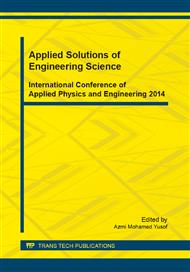p.137
p.143
p.148
p.154
p.160
p.168
p.176
p.183
p.190
Analysis of Atmospheric Parameters Variation on Effeciency of Polycrystalline PV System in a Tropical Station
Abstract:
The photovoltaic (PV) system output performance is not independent as it varies over extended periods as well as it depends on the varying atmospheric conditions. In this work, the effect of ambient temperature and relative humidity on the efficiency performance of the polycrystalline PV system was investigated and analyzed in a tropical region. This was done by using a measurement system consists of sensors for measuring both electrical of the system and the atmospheric parameters concurrently at interval of time for a period of a year at the back of Pure and Applied Physics Department, Ladoke Akintola University of Technology Ogbomoso, Nigeria. From the measurements obtained, it was deduced that the performance efficiency of the system varied with the variation in the magnitude of the atmospheric parameters. The maximum daily value of efficiency obtained was 55% between the ambient temperature and relative humidity of 33oC to 34oC and 50% to 55% respectively. This can serve as a baseline to the PV designers and users for adequate installation of the system in the study area and other areas that have similar solar characteristics.Key words: Photovoltaic, polycrystalline, solar cell, semiconductor, efficiency.Corresponding Author:
Info:
Periodical:
Pages:
160-167
Citation:
Online since:
October 2014
Authors:
Keywords:
Price:
Сopyright:
© 2014 Trans Tech Publications Ltd. All Rights Reserved
Share:
Citation:


